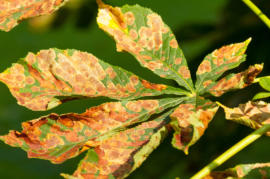Keeping up with virus taxonomy: small viruses, extra small viruses and a virus used to protect against fungal disease
Posted on March 27, 2019 by Laura Cox
Continuing the ‘Keeping up with virus taxonomy’ blog series, in this post we will be discussing the virus family named after Latin for 'small', a virus that can only cause disease in humans infected with hepatitis B and the virus being used to protect chestnut crops from a harmful fungus.
Parvoviridae:

Named after the Latin word for small – parvus – viruses in the Parvoviridae family are just 23-28 nanometres (nm) in diameter. This family contains two subfamilies with over 75 distinct species. These are capable of infecting a range of hosts including mammals, birds, reptiles, insects and crustaceans.
Perhaps one of the most well-known examples of a virus in the Parvoviridae family is Canine parvovirus (CPV). CPV is a severe disease that is often fatal; in unvaccinated animals, the mortality rate can be as high as 90%. The virus is spread through the faecal-oral route and attacks the intestinal tract, causing internal bleeding and intense dehydration.
Only five of the 75 viruses in Parvoviridae are known to infect humans. Most of these viruses do not cause disease, but two — bocaparvovirus and erythroparvovirus — cause disease.
Sarthroviridae:
If parvoviruses are small, viruses in the Sarthroviridae family are tiny. At just 15 nm in diameter, the one species in this family is classified as an ‘extra small virus’. The virus, called Macrobrachium satellite virus 1 is a satellite virus, meaning it requires another, larger virus called Macrobrachium rosenbergii nodavirus to infect its host and replicate.
These viruses infect giant freshwater prawns and cause a disease called white tail disease. Both viruses must be present for the disease, which causes mass mortality in prawn populations, to occur. There are no other known hosts for Macrtobacterium satellite virus 1.
Deltavirus:
Another virus that can only cause infection with the presence of another virus is hepatitis delta virus (HDV). People infected with HDV are more likely to have severe symptoms of hepatitis B infection, including an increased risk of developing liver cancer and a greater likelihood of the disease progressing to liver failure.
Hypoviridae:

This virus family consists of four species. Unlike most other viruses, hypoviruses do not have a capsule, meaning they cannot form rigid particles and do not have structural proteins.
Hypoviruses infect fungi and cause a disease known as host-virulence reduction. Hypovirus CHV1 reduces the damage caused by the fungal disease chestnut blight and has been important in protecting European and North American chestnut crops since the 1970s.
The International Committee on Taxonomy of Viruses (ICTV) is responsible for developing and maintaining a universal virus taxonomy. Known viruses are categorised into a classification scheme taking into consideration their physical and biological properties in combination with their phylogenetic relationships.
Thanks to funding from the Wellcome Trust, two-page summaries of each chapter of the ICTV Report (a free resource published by the ICTV which provides an up-to-date description of virus taxonomy) are freely available in the Journal of General Virology. These summaries are known as ICTV Virus Taxonomy Profiles and describe the structure, replication and taxonomy of each virus order and family.

